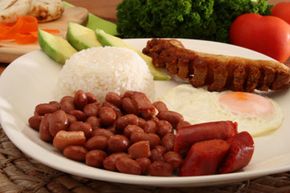Traditional Colombian Food
Colombia's national dish, bandeja paisa, is so rich and satisfying that you might feel the need to unbutton your pants afterward. True to its name, bandeja paisa ("paisa platter") is generally served on a large tray (bandeja) rather than a normal-sized plate. On it, you'll find red beans and rice, ground beef, chorizo, plantains, arepa (cornmeal bread) and avocado. The entire work is topped with fried eggs and, to make the dish even more decadent, sometimes a large slice of chicharron (fried pork belly) is added. Wash it all down with a large glass of mazamorra (cold milk with crushed maize) and be sure to wear elastic-waist pants for maximum enjoyment!
Although bandeja paisa is well known throughout the country, many other Colombian dishes are regional favorites [sources: Woodward, Puerta]:
Advertisement
- Llanos region: Indigenous tribes who inhabited the grassland areas of Colombia's northeast created a regional delicacy that is still enjoyed today. Hormigas culonas (literally, "big-butt ants") are harvested during the rainy season, soaked in salt water and roasted in a ceramic pot. While ants may be considered a delicacy by locals, people from other regions of Colombia wouldn't necessarily agree. The llanos region is also known for its barbecued meats, which may be prepared in the traditional way on a vertical spit over an open fire.
- Coastal regions: Coconut rice (arroz con coco) is a mainstay along both the Atlantic and Pacific coasts of Colombia. Arepa (cornmeal bread) is served in many variations on the coast, including stuffed with cheese (arepa de queso) and served with egg (arepa de huevo). In general, food in Colombia's coastal regions tends to be spicy. Some of it, such as mote de queso con hogao (a soup with cheese and yam, topped with hogao, a savory condiment made from tomatoes, onions and peppers) reveals a blend of African and Criollo influences.
- Andean region: Ajiaco (chicken soup with corn, potatoes, avocado and guascas, a local herb) and changua (breakfast soup made with eggs, milk and scallions) are favorites of the Andean region.
A list of Colombian food wouldn't be complete without a mention of Colombia's exotic fruits, including lulo, curuba, mamoncillo, uchuva, chontaduro,zapote and many others.
We hope you enjoyed this taste of traditional Colombian culture. If you're still hungry, satisfy your curiosity by checking out the Lots More Information section below.
Related Articles
Sources
- Árquez, Samuel M. and Roadfield, Douglas C. “Colombia.” everyculture.com. (Aug. 9, 2011) http://www.everyculture.com/Bo-Co/Colombia.html
- Associated Press. "U.S. Ugrades Colombia's Human Rights Score." The New York Times. Sept. 11, 2009. (Aug. 13, 2011) http://www.nytimes.com/2009/09/12/world/americas/12colombia.html?ref=Colombia
- "Background Note: Colombia." U.S. Department of State. July 13, 2011. (Aug. 13, 2011.) http://www.state.gov/r/pa/ei/bgn/35754.htm
- Carr, David. "Villa de Leyva, a Graceful Window on Colonial Colombia." The New York Times. Oct. 22, 2009. (Aug. 13, 2011) http://travel.nytimes.com/2009/10/25/travel/25explorer.html
- "Colombia" Nationsonline.org. June 2, 2011. (Aug. 12, 2011) http://www.nationsonline.org/oneworld/colombia.htm
- "Colombia: Physical and Human Geography" Encyclopedia Britannica. 1995. (Aug. 13, 2011.) http://www.uv.es/EBRIT/macro/macro_5001_39_0.html
- "Colombian Holidays, Fairs and Festivals" ProExport.com. (Aug. 13, 2011.) http://www.colombia.travel/en/international-tourist/sightseeing-what-to-do/history-and-tradition/fairs-and-festivals
- "Concurso Nacional de Belleza." srtacolombia.org. (Aug. 9, 2011) http://translate.google.com/translate?hl=en&sl=es&u=http://www.srtacolombia.org/&ei=nHlBTtWoNMugtgeq19y9CQ&sa=X&oi=translate&ct=result&resnum=1&ved=0CCgQ7gEwAA&prev=/search%3Fq%3DReinado%2Bde%2BBelleza%26hl%3Den%26client%3Dfirefox-a%26hs%3Dzor%26rls%3Dorg.mozilla:en-US:official%26prmd%3Divnso
- Foster, Nick. "Colombia's Capital Finds New Sense of Optimism." The New York Times. Jan. 28, 2010. (Aug. 9, 2011) http://www.nytimes.com/2010/01/29/greathomesanddestinations/29ihtrebogota.html?adxnnl=1&ref=colombia&adxnnlx=1312918398-6kI8adYMKwJb4QH2GuZPnw
- Frommer's. "Introduction to Colombia." The New York Times. (Aug. 9, 2011) http://travel.nytimes.com/frommers/travel/guides/central-and-south-america/colombia/frm_colombia_2844010001.html
- Jaramillo, Andrés Muñoz. “A Small Trip Through Colombian Music.” physics.montana.edu. Oct. 15, 2007. (Aug. 13, 2011) http://solar.physics.montana.edu/munoz/AboutMe/ColombianMusic/English_Content.html
- Mauleon, Rebeca. "Colombia" National Geographic (Aug.13, 2011) http://worldmusic.nationalgeographic.com/view/page.basic/country/content.country/colombia_48
- Puerta, Maribel. "Bandeja Piasa." DiscoverColombia.com. (Aug. 13, 2011) http://www.discovercolombia.com/category/food-blog/
- "The Sombrero Vueltiao." ProExport Colombia. (Aug. 13, 2011) http://www.colombia.travel/en/international-tourist/sightseeing-what-to-do/history-and-tradition/handicrafts/colombian-textile-work/sombrero-vueltiao
- Varney, John. "Colombian Bambuco: The Evolution of a National Musical Style." Thesis submitted to Queensland Conservatorium, Griffith University. May, 1999. (Aug. 13, 2011.) http://www4.gu.edu.au:8080/adt-root/uploads/approved/adt-QGU20030303.105101/public/01Front.pdf
- Woodward, Rob. "Typical Colombian Food." Southamerica.cl.com. July 5, 2011. (Aug. 9, 2011) http://www.southamerica.cl/Colombia/Food.htm
